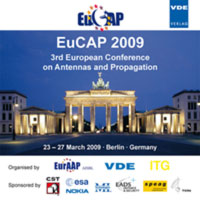Comparison Between CRLH Zeroth-Order Antenna and Series-Fed Microstrip Patch Array Antenna
Konferenz: EuCAP 2009 - 3rd European Conference on Antennas and Propagation
23.03.2009 - 27.03.2009 in Berlin, Germany
Tagungsband: EuCAP 2009
Seiten: 4Sprache: EnglischTyp: PDF
Persönliche VDE-Mitglieder erhalten auf diesen Artikel 10% Rabatt
Autoren:
Liebig, T.; Rennings, A.; Erni, D. (General and Theoretical Electrical Engineering (ATE), University of Duisburg-Essen, 47048 Duisburg, Germany)
Otto, S. (Microwave Department (HFT), University of Duisburg-Essen, 47048 Duisburg, Germany)
Caloz, C. (Poly-Grames Research Center, École Polytechnique de Montréal, Montréal, H3T 1J4, Québec, Canada)
Inhalt:
A metal-insulator-metal (MIM) composite right/left-handed (CRLH) series-mode zeroth-order resonant antenna (ZORA) optimized for the 24 GHz ISM band is presented and compared to a series-fed patch array (SFPA) antenna. The CRLH ZORA exhibits superior performances for relatively short lengths (< 3lambda0) whereas the SFPA may performs better, depending on the specific design, when the length is very long (> 5lambda0), so that the resonant antennas operate as leaky-wave antennas with a leakage factor proportional to the density of the radiators along the structure. To our knowledge it the first time that the leaky-wave operation of an electrically very large “resonator” has been explicitly identified. The ZORA is particularly recommended for average electrical sizes in the order of 2lambda0, where it should be systematically superior to a SFPA.


